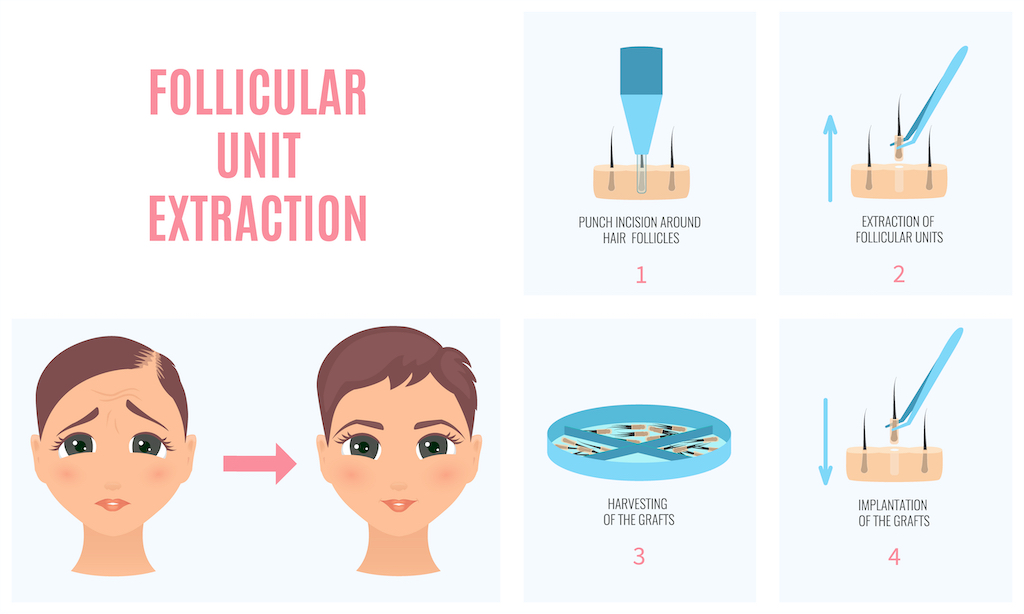Shamila Gupta Rawal, MD, a board-certified otolaryngologist/head and neck surgeon, specializes in the management of hair loss and rejuvenation of the face and neck at The Rawal Institute for Hair Restoration and Aesthetic Medicine. Dr. Rawal the only hair restoration surgeon providing comprehensive surgical and non-surgical treatment for all types of hair loss in Madison, Wisconsin, with an expansive patient base that travels from coast to coast. Haute Beauty sits down with Dr. Shamila Rawal to discuss what causes hair loss for women and the hair transplant surgeries used.
 Photo Credit: ShutterstockHaute Beauty: What causes hair loss for women?
Photo Credit: ShutterstockHaute Beauty: What causes hair loss for women?
40% of women suffer from hair loss, with causes including hormonal imbalance, the strain on the body (stress, nutritional deficiencies, recent infection/surgery, change in medications, trauma/traction), and autoimmune or inflammatory disorders. Having a thorough medical evaluation is important to determine which of the above is the source of hair loss since treatment will vary with the cause. Additionally, there are rare skin conditions that can lead to permanent hair loss, so it is important to be seen early. Some forms of hair loss are temporary in nature, occurring after the body has suffered a strain or demand on its resources. This condition is called telogen effluvium and usually begins 3-6 months following a stressful change, and then ends 3-6 months following cessation of the stressor. Another form of hair loss is female pattern baldness, which mirrors male pattern baldness in its genetic and hormonal source. Scarring and autoimmune alopecia (hair loss) can be the result of underlying systemic hyperreactivity and often require treatments locally in the scalp, as well as globally in the body. During your visit, I conduct a comprehensive examination, including a microscopic exam of your hair follicles, to best understand the cause of your hair loss and determine what options we have for treatment. I may ask you to obtain laboratory tests to further investigate how your hair loss fits into the bigger picture of your health.
HB: How does hair transplant surgery for women work, and how does it differ from men?
A hair transplant procedure in both males and females involves harvesting healthy hair from a donor site, then surgically implanting those hairs where you have thinning hair or balding. There are two important criteria to meet in order to know if you are a good candidate for a transplant. First, you need to have enough donor hair to adequately restore the current and projected area of thinning or balding. And second, the balding area must be able to grow hair. For example, your skin may not support a new transplant if you have scarring hair loss that affects blood vessels and skin quality, or if thinning has been long-standing. Sometimes, I will pre-condition the scalp with PRP (platelet-rich plasma) and microneedling, to optimize the environment for a future transplant.
While hair transplant in men and women entails the same technical process, there is a major difference. Male pattern baldness typically affects the top of the head, sparing the sides and back, because the receptors for the hormone DHT (dihydrotestosterone) are concentrated here. Females, on the other hand, have DHT receptors more widely spread, so they suffer from thinning throughout their head, rather than just on the top. When planning hair restoration for males, the goal is to restore visible density that approximates the density of the “safe zones,” and to restore their hairlines or temples to younger times. Because females suffer more diffuse thinning, the goal of transplant is not to restore density in all the thin areas, rather focus restoration to those areas that are influential for styling and camouflage. Additionally, women will often undergo a hybrid procedure with some transplant and some scalp micropigmentation, to enhance the illusion of greater density.
 Photo Credit: ShutterstockHB: Are there different types of procedures?
Photo Credit: ShutterstockHB: Are there different types of procedures?
There are two main approaches to hair transplant surgery: follicular unit transplantation (FUT) and follicular unit extraction (FUE). FUT is sometimes called strip transplantation because your donor's hair is harvested by removing a long, thin strip of skin from the back and sides of your scalp. After removing the strip of healthy hair, the skin is sutured back together. When you have FUE, your hair is harvested using small circular punches that remove individual follicular units one at a time. The hairs are then transplanted the same way as a FUT transplant. While FUT allows me to harvest a larger number of hairs at one time, FUE offers other advantages, such as quicker healing of the donor sites. While males may choose between FUT (strip) or FUE (individually punched graft) procedures equally, females will lean preferentially toward the FUT (strip) procedure, in order to maximize the yield of the harvest and to maintain their long hair.
HB: Is the procedure painful?
In my office, I administer nerve block injections to keep you comfortable throughout all the steps of surgery. The administration of the nerve block injections can be a little uncomfortable for a couple of minutes, but afterward, you should not feel any sharp sensations or pain. You may feel me and my team working on your head, and you might also feel an occasional pressure or heaviness sensation, during different steps in surgery, but you should not feel pain. Using only this local anesthesia allows my patients the freedom to use the bathroom or take stretch breaks during the procedure and to enjoy lunch midday, without being overly sleepy.
HB: What is recovery like?
Recovery is essentially 48 hours of “stay-at-home” downtime, followed by 2 weeks of lighter physical activity. After surgery, my patients will go home with a bandage that is removed after 24 hours. They can shower, but not get their heads wet until they then see me on Day 2, at which time I examine the recipient site and donor site, and give them permission to start shampooing. This permission also extends to being able to wear a hat without the worry of disturbing or displacing any of the implanted grafts, so my patients are able to return to work or their usual daily routines inside or outside the home. Physical activity is restricted for 2 weeks, so as to not put undue strain on the donor incision and minimize the risk of a stretched scar. Swimming is prohibited for 8 weeks, but getting a haircut is allowed after 2 weeks and coloring is allowed after 6 weeks.


























